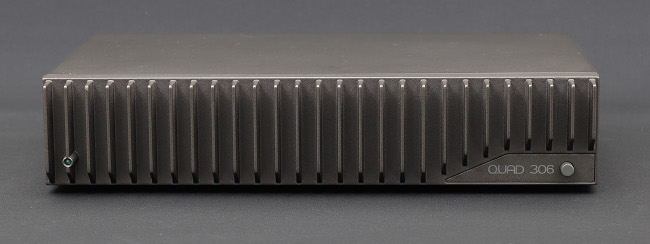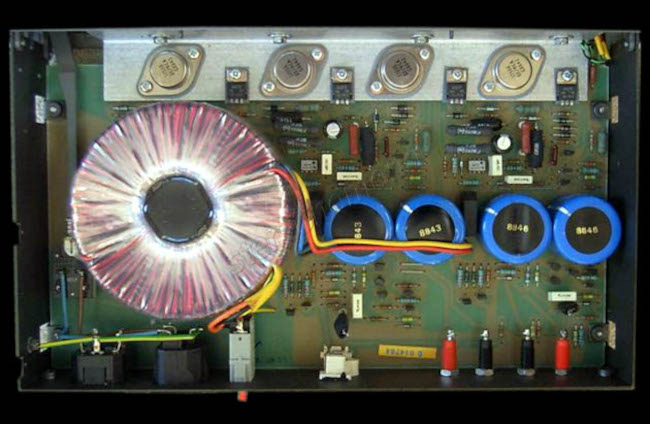They don’t make them like that any more: the Quad 306 amplifier

British electronics company Quad was known mostly for its signature electrostatic loudspeakers – monstrous, window-sized slabs with brass mesh grills – but it also did a good business in amplifiers and other hifi equipment. The 306 was more-or-less the last product released by the Company under the auspices of its founder, Peter Walker, and probably the best.
The 306 is a power amplifier. It has no controls except an on/off switch, and no connections except input, speakers, and mains. When it was released in 1987 you’d use it with a preamplifier, which had the actual controls, and a bunch of separate audio sources. These days you’d probably do the same, but it’s perfectly possible to connect the Quad 306 directly to the output of a computer’s soundcard, and it will work fine.
Walker notoriously said that the perfect power amplifier is “a wire with gain”. That is, the amplifier should make the electrical signal larger, but not modify it in any other way. Such a goal is difficult to achieve, and there’s been much discussion about whether it’s even worth attempting. Still, the design goal of the 306, and it’s predecessor the 405 range (yes, Quad product naming was bizarre) was for the amplifier to be as transparent as possible. Any modification to the audio properties would be done elsewhere.
Whether that was a laudable goal in 1987 is debatable, but it’s certainly a laudable goal now: with digital signal processing technology we can now make pretty-much anything sound like anything else. There’s little need for an amplifier to do more than enlarge.

The 306 could, in principle, produce a constant 50 watts into two 8-ohm speakers. Music being what it is, that meant in practice about ten watts, with the extra power reserved for peaks. It was, and remains, plenty loud in a domestic setting. The case was comparatively small for the time, and there were no cooling fans. So heat management was by a substantial heat sink, mounted unconventionally on the front. The whole unit was a dull, industrial grey, at a time when brushed aluminium was all the rage. Certainly it looked businesslike.
Mounting the heat sink on the front makes sense, from a technical perspective, because there was little else on the front panel. The rear had all the connections, so a rear heat sink could not have been as large, and the wiring would have been complicated. The internal layout of the 306 is, in fact, very simple.

All the electronics are mounted on a single, single-sided printed circuit board. It’s relatively easy to dismantle the whole thing for servicing and modifications. And there was plenty of modification, from simple upgrades to the speaker sockets, to radical changes to the electronics.
A notable factor about the design is the small number of electrolytic capacitors. There are only four – the massive power smoothing capacitors. They have to be this large to store the energy needed to deliver powerful transients – the thump of a bass drum, for example. Minimizing the number of electrolytic capacitors matters because these devices change their electrical properties as they age.
Quad made much of the fact that the electronic design was non-critical in its component choices. If you replaced, for example, a 95-ohm resistor with a 110-ohm resistor it wouldn’t do any harm. Because resistors were not made to tight tolerances in the 1980s – cheap ones still are not – this lack of fussiness was important for maintenance.
You might also notice that there are no internal adjustments of any kind. Either the 306 works perfectly straight from the assembly line, or it doesn’t work at all. The basic electronic design principle was called by Quad ‘current dumping’. It’s a principle that lends itself to unfussy component selection and layout.
A hifi power amplifier was a relatively specialist piece of equipment in the 80s, as it is now. Then, as now, only enthusiasts with plenty of funds would assemble a hifi system from separate components; everybody else had some sort of ‘music centre’ that integrated everything together. ‘Everything’ in 1987 might have included a CD player but, for most people, good-quality music sources were FM radio and vinyl records. Plebs like me played cassette tapes, but real enthusiasts scorned such things, just as they scorned the ‘music centres’, which generally were cheap and nasty, and sounded awful.
So anybody who wanted a separate power amplifier in the 80s would expect to have to pay in hard coin: the 306 cost about £1500 in 2024 money. Looking inside one, it’s pretty clear that it doesn’t contain £1500’s worth of components. Presumably some of that money went into the design process, but it’s hard to avoid the conclusion that some of it went into the name: Quad was a prestige brand in the 70s and 80s. Everybody with an interest in hifi knew about Quad, just as everybody with an interest in cars knew about Jaguar.
If you spend such a lot of money on an amplifier, you’re probably going to find that it sounds good. But the one I bought for £40 ten years ago sounded pretty good as well. I sold it because it, and the additional equipment that went with it, was too large for the shelf in my office. The Denon compact system I replaced it with was a lot more convenient, and a space-saver, but it didn’t sound so good.
Of course, the 306 wasn’t perfect. An obvious, irritating problem was that it was all too easy to trip the over-current protection by playing it too loud. The protective device did not auto-reset – you had to grope around behind the stack of hifi equipment to find the tiny reset button on the back of the 306. But probably the worst fault was that the enormous mains transformer wasn’t mounted on the chassis, but on the printed circuit board. If you dropped the amplifier, there was a good chance that you’d crack the circuit board. This was repairable, but not easily.
Given how good the 306 was, it’s not obvious why it wasn’t more of a success. In fact, by 1987, Quad’s amplifier business was already in decline. According to Ken Kessler’s book Quad: The Closest Approach, the 405-2 – the predecessor of the 306 – sold about 100,000 units. The 306 and all the amplifiers that came after it did not sell that many together.
I suspect that part of the reason for the decline was the increased popularity of CD players. One of the things that CDs taught us was that an amplifier probably wasn’t the limiting factor in sound quality. If you had half-decent speakers and a CD player, even an inexpensive amplifier could sound pretty good. Not as good, perhaps, as a top-flight unit, but good enough for most people.
At the same time, the quality of integrated hifi systems started to improve. It was, and remains, possible to get bettter sound from carefully chosen, separate components; but the difference gets smaller every year. My Denon compact system included a CD player and DAB/FM/AM radio along with the amplifier and speakers, and it still cost only a quarter as much as a Quad 306.
If you want a Quad 306 today – and I strongly recommend it – you can pick up a reasonable one from an on-line auction sites for about £200. You should probably replace the huge capacitors if the previous owner did not, because capacitors of that size don’t age well. You should also check the PCB for cracks at the same time. With these simple things taken care of, the 306 will probably outlive you, and still be sounding great when it does.
